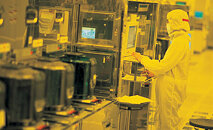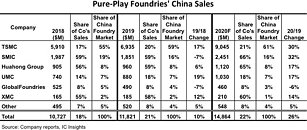- Joined
- Aug 19, 2017
- Messages
- 2,918 (1.05/day)
IC Insights recently released its September Update to the 2020 McClean Report that presented the second of a two-part analysis on the global IC foundry industry and included a look at the pure-play foundry market by region.
China was responsible for essentially all of the total pure-play foundry market increase in 2018. In 2019, the U.S./China trade war slowed China's economic growth but its foundry marketshare still increased by two percentage points to 21%. Moreover, despite the Covid-19 shutdown of China's economy earlier this year, China's share of the pure-play foundry market is forecast to be 22% in 2020, 17 percentage points greater than it registered in 2010 (Figure 1).


Japan is expected to remain the smallest market for pure-play foundry sales with only a 5% share this year (up only two points from its share in 2010). With its foundry market forecast to be worth about $3.6 billion in 2020, Japan's share of pure-play foundry sales is expected to be about 10% the size of the 2020 Americas pure-play foundry market ($35.1 billion).
IC Insights believes that the Japanese market for pure-play foundry services will increase only slightly in the future. The fabless IC company infrastructure in Japan is small and not expected to grow much over the next five years. Therefore, almost all of the growth in foundry demand in Japan is expected to come from a greater number of Japanese IDMs (e.g., Renesas, Toshiba, Sony, etc.), utilizing IC foundry services.
The rise of HiSilicon and other fabless IC companies in China has elevated the demand for foundry services in that country. Figure 2 shows IC Insights' listing of the top pure-play foundries' sales in China in 2018-2020.

In total, pure-play foundry sales in China increased by 10% in 2019 to $11.8 billion, much better than the 1% decline in the total pure-play foundry market last year. Moreover, in 2020, pure-play foundry sales to China are forecast to jump by 26%, seven points better than the 19% increase expected to be registered by the total pure-play foundry market this year.
As shown, UMC showed the highest sales increase into China last year with a 19% jump. This increase was driven by the continued ramp up of its Fab 12X located in Xiamen, China, which opened in late 2016. The fab currently has capacity of 18.7K 300 mm wafers per month. An expansion to 25.0K wafers per month is expected to be complete in mid-2021.
Following a 59% jump in 2018, TSMC's sales into China increased by another 17% in 2019 to $6.9 billion. As a result, the China market was responsible for essentially all of TSMC's sales increase last year with China's share of the company's sales more than doubling from 9% in 2016 to 20% in 2019. In 2020, China-based SMIC and Taiwan-based TSMC are forecast to register strong sales increases in China of 32% and 30%, respectively. For SMIC, a 32% sales increase into China this year would be a big turnaround from the 7% decline in China sales the company logged in 2019.
TSMC had strong sales into China in the second half of last year that were boosted by sales of 7nm application processors to fabless IC supplier HiSilicon. In the first half of 2020, TSMC's sales into China flattened at $2.2-$2.3 billion per quarter. Given that TSMC's device shipments to HiSilicon ended in mid-September, it remains to be seen if that revenue can be replaced in 4Q20 with sales from other China-based companies.
View at TechPowerUp Main Site
China was responsible for essentially all of the total pure-play foundry market increase in 2018. In 2019, the U.S./China trade war slowed China's economic growth but its foundry marketshare still increased by two percentage points to 21%. Moreover, despite the Covid-19 shutdown of China's economy earlier this year, China's share of the pure-play foundry market is forecast to be 22% in 2020, 17 percentage points greater than it registered in 2010 (Figure 1).


Japan is expected to remain the smallest market for pure-play foundry sales with only a 5% share this year (up only two points from its share in 2010). With its foundry market forecast to be worth about $3.6 billion in 2020, Japan's share of pure-play foundry sales is expected to be about 10% the size of the 2020 Americas pure-play foundry market ($35.1 billion).
IC Insights believes that the Japanese market for pure-play foundry services will increase only slightly in the future. The fabless IC company infrastructure in Japan is small and not expected to grow much over the next five years. Therefore, almost all of the growth in foundry demand in Japan is expected to come from a greater number of Japanese IDMs (e.g., Renesas, Toshiba, Sony, etc.), utilizing IC foundry services.
The rise of HiSilicon and other fabless IC companies in China has elevated the demand for foundry services in that country. Figure 2 shows IC Insights' listing of the top pure-play foundries' sales in China in 2018-2020.

In total, pure-play foundry sales in China increased by 10% in 2019 to $11.8 billion, much better than the 1% decline in the total pure-play foundry market last year. Moreover, in 2020, pure-play foundry sales to China are forecast to jump by 26%, seven points better than the 19% increase expected to be registered by the total pure-play foundry market this year.
As shown, UMC showed the highest sales increase into China last year with a 19% jump. This increase was driven by the continued ramp up of its Fab 12X located in Xiamen, China, which opened in late 2016. The fab currently has capacity of 18.7K 300 mm wafers per month. An expansion to 25.0K wafers per month is expected to be complete in mid-2021.
Following a 59% jump in 2018, TSMC's sales into China increased by another 17% in 2019 to $6.9 billion. As a result, the China market was responsible for essentially all of TSMC's sales increase last year with China's share of the company's sales more than doubling from 9% in 2016 to 20% in 2019. In 2020, China-based SMIC and Taiwan-based TSMC are forecast to register strong sales increases in China of 32% and 30%, respectively. For SMIC, a 32% sales increase into China this year would be a big turnaround from the 7% decline in China sales the company logged in 2019.
TSMC had strong sales into China in the second half of last year that were boosted by sales of 7nm application processors to fabless IC supplier HiSilicon. In the first half of 2020, TSMC's sales into China flattened at $2.2-$2.3 billion per quarter. Given that TSMC's device shipments to HiSilicon ended in mid-September, it remains to be seen if that revenue can be replaced in 4Q20 with sales from other China-based companies.
View at TechPowerUp Main Site




